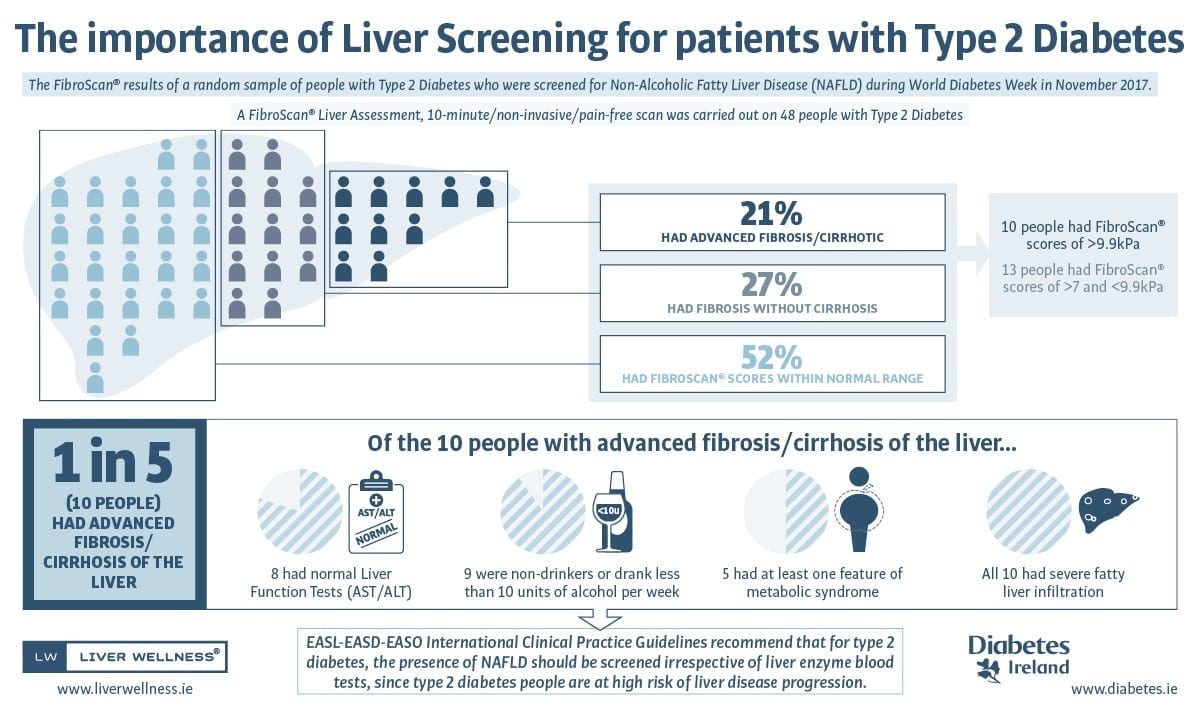A recent Irish liver screening initiative supports the International Clinical Guideline recommendations that all people with type 2 diabetes should be screened for Non-Alcoholic Fatty Liver Disease
There is a silent epidemic of Non-Alcoholic Fatty Liver Disease (NAFLD) in Ireland. People with type 2 diabetes, obesity and/or high cholesterol are at greater risk of developing this disease, which, if left undiagnosed and untreated, may lead to cirrhosis of the liver. However, awareness among patients and healthcare providers in this country is extremely low leading to underdiagnoses, under-treatment and increased mortality.
To highlight the serious risk that NAFLD poses for people with type 2 diabetes and to raise the much needed awareness within the diabetes community in Ireland, Ireland’s first “Diabetes Liver Screen Initiative” was held in November 2017. This was a collaborative-led initiative between Diabetes Ireland and Professor Suzanne Norris (St James’s Hospital and Liver Wellness®).
Members of Diabetes Ireland with type 2 diabetes were invited to participate in this screening initiative which included the innovative FibroScan® technology, a 10-minute/non-invasive/pain-free FibroScan® test. Liver Health Screening took place during World Diabetes Week in November 2017. Each participant received their result on the day of their scan and a consultant report with recommendations (where necessary) was sent to each person and their GP/consultant so that appropriate treatment could commence immediately.
Following completion of the screening initiative and review of clinical outcomes, Professor Norris will speak on “NAFLD and Diabetes” at the Diabetes Ireland DICE conference in Croke Park on Friday, 23rd February. At this meeting, Professor Norris will announce the significant outcomes of the screening initiative, outcomes which support the implementation of International Clinical Practice Guidelines recommendations into Irish clinical practice: “in patients with type 2 diabetes, the presence of NAFLD should be looked for irrespective of liver enzyme blood tests, since type 2 diabetes patients are at high risk of liver disease progression”. Please see the Infographic below which illustrates the results of the Irish Liver Screening Initiative.
Dr Anna Clarke, Health Promotion Manager – “Diabetes Ireland were delighted to offer this service to our members but more importantly the startling results on this small cohort of people indicate the need to extend this to become part of routine screening similar to the eye (retinascreen) and foot assessment that is an essential part of the annual review. NAFLD is not something that is routinely checked in Type 2 diabetes patients with normal liver function blood results but it should be”
Professor Suzanne Norris, Consultant Hepatologist – “This initiative has been life-changing for many of those screened. For those 1 in 5 patients with advanced fibrosis/cirrhosis, awareness means they can now take the necessary steps to prevent further liver damage and to prevent complications such as liver cancer”
ADDITIONAL INFORMATION
NAFLD – A disease associated with diabetes and the obesity epidemic
As the name suggests, non-alcoholic fatty liver disease (NAFLD), is different to liver disease caused by excessive alcohol intake. NAFLD is common in people with type 2 diabetes, high BMIs and/or having a high intake of fat and sugar, commonly referred to as the ‘Western diet’.
It has become the most common liver disease in western countries and is the number one cause of cirrhosis and hepatocellular carcinoma in the Western world. It is estimated that Ireland is set to become Europe’s most overweight nation by 2025, according to a recent report by the scientific Journal. It is estimated that 36% of the Irish population aged over 50, are classified as obese, and a further 43% are overweight which implies that the prevalence of NAFLD in Ireland is likely to increase significantly in the years to come.
Health risks associated with obesity such as high blood pressure, high cholesterol, heart disease and type 2 diabetes are well known, but awareness of the impact on liver health is under the radar.
NAFLD – FACTS
Non-Alcoholic Fatty Liver Disease is defined as an excess of fat on the liver in the absence of increased alcohol intake. There are several factors that increase the risk of developing Fatty Liver and these include diabetes (type 2), high blood pressure, high cholesterol and being over-weight or obese. Approximately, 20% of patients diagnosed with Fatty Liver will develop fat-related inflammation of the liver, called Non-Alcoholic Steato-Hepatitis (NASH). NASH can lead to liver damage and scarring (fibrosis) and if untreated over time, can lead to cirrhosis of the liver.
What is of concern is that NAFLD often displays no symptoms and routine liver blood tests (LFTs) do not differentiate NAFLD from NASH or accurately stage fibrosis (liver scarring).
International Clinical Practice Guidelines recommend that for type 2 diabetes patients, the presence of NAFLD should be screened irrespective of liver enzyme blood tests, since type 2 diabetes patients are at high risk of liver disease progression. The FibroScan liver assessment has been recommended as a validated non-invasive procedure for the identification of patients at risk of NAFLD (in some cases, a liver biopsy may be required).
NAFLD can be prevented and/or reversed through healthy eating, exercise and weight reduction.
______________________________________________________________________
For further media queries or to arrange an interview with Professor Norris, please contact:
Em: doloresbarry@liverwellness.ie
Ph: Dolores Barry – 087 238 7426
W: www.liverwellness.ie FB: liverwellnessireland


